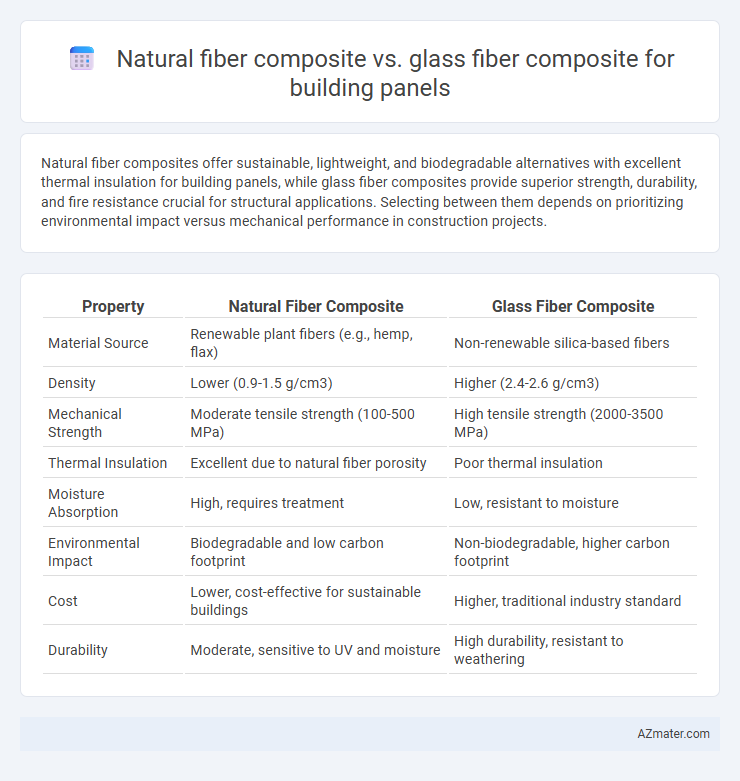Natural fiber composites offer sustainable, lightweight, and biodegradable alternatives with excellent thermal insulation for building panels, while glass fiber composites provide superior strength, durability, and fire resistance crucial for structural applications. Selecting between them depends on prioritizing environmental impact versus mechanical performance in construction projects.
Table of Comparison
| Property | Natural Fiber Composite | Glass Fiber Composite |
|---|---|---|
| Material Source | Renewable plant fibers (e.g., hemp, flax) | Non-renewable silica-based fibers |
| Density | Lower (0.9-1.5 g/cm3) | Higher (2.4-2.6 g/cm3) |
| Mechanical Strength | Moderate tensile strength (100-500 MPa) | High tensile strength (2000-3500 MPa) |
| Thermal Insulation | Excellent due to natural fiber porosity | Poor thermal insulation |
| Moisture Absorption | High, requires treatment | Low, resistant to moisture |
| Environmental Impact | Biodegradable and low carbon footprint | Non-biodegradable, higher carbon footprint |
| Cost | Lower, cost-effective for sustainable buildings | Higher, traditional industry standard |
| Durability | Moderate, sensitive to UV and moisture | High durability, resistant to weathering |
Introduction to Composite Materials in Building Panels
Composite materials for building panels combine two or more distinct materials to achieve enhanced mechanical properties, durability, and sustainability. Natural fiber composites utilize fibers such as jute, flax, or hemp embedded in a resin matrix, offering eco-friendly advantages like biodegradability and lower carbon footprint compared to glass fiber composites. Glass fiber composites provide superior strength, fire resistance, and moisture durability, making them suitable for high-performance applications but often involve higher environmental impact due to energy-intensive manufacturing.
Overview of Natural Fiber Composites
Natural fiber composites for building panels utilize renewable materials such as hemp, flax, jute, and sisal, offering advantages in sustainability and biodegradability compared to traditional glass fiber composites. These composites provide favorable mechanical properties, including good strength-to-weight ratios and enhanced thermal and acoustic insulation. Their lower environmental impact and potential for reduced production costs make natural fiber composites increasingly attractive for eco-friendly construction applications.
Overview of Glass Fiber Composites
Glass fiber composites consist of fine glass fibers embedded in a polymer matrix, offering high tensile strength, durability, and resistance to moisture and chemicals, which makes them ideal for building panels. These composites demonstrate excellent impact resistance and dimensional stability, ensuring long-term performance in structural and non-structural applications. Compared to natural fiber composites, glass fiber composites provide superior mechanical properties and fire resistance, though they are less sustainable and heavier.
Mechanical Properties Comparison
Natural fiber composites exhibit lower density and enhanced biodegradability compared to glass fiber composites, providing lightweight solutions for building panels. Glass fiber composites demonstrate superior tensile strength, impact resistance, and stiffness, making them favorable for structural applications requiring high mechanical performance. Despite their lower mechanical properties, natural fiber composites offer adequate durability and flexibility for non-load-bearing panels, contributing to sustainable construction practices.
Thermal and Acoustic Insulation Performance
Natural fiber composites exhibit superior thermal insulation properties due to their low thermal conductivity and high moisture regulation capacity, making them ideal for reducing energy consumption in building panels. Glass fiber composites provide excellent acoustic insulation with high sound absorption coefficients, effectively dampening noise in construction environments. However, natural fibers offer a more sustainable option with breathable structures that balance both thermal and acoustic performance, while glass fibers deliver durable, fire-resistant solutions.
Environmental Impact and Sustainability
Natural fiber composites for building panels significantly reduce environmental impact due to their biodegradability, lower carbon footprint, and renewable sourcing from materials such as hemp, flax, and jute. In contrast, glass fiber composites rely on energy-intensive production processes and non-renewable silica resources, resulting in higher embodied energy and longer decomposition periods. Sustainable building practices increasingly favor natural fibers for their ability to enhance recyclability and contribute to circular construction economies.
Cost Analysis and Economic Feasibility
Natural fiber composites for building panels typically offer lower material costs and reduced environmental impact compared to glass fiber composites, making them economically attractive for sustainable construction projects. The manufacturing process for natural fiber composites often requires less energy, contributing to overall cost savings and improved feasibility for large-scale production. However, glass fiber composites may provide higher durability and strength-to-weight ratios, potentially justifying their higher initial costs in applications demanding long-term performance.
Durability and Maintenance Requirements
Natural fiber composites for building panels offer moderate durability with good resistance to moisture when properly treated, but generally require more frequent maintenance to prevent degradation from UV exposure and biological factors. Glass fiber composites provide superior durability due to their high resistance to corrosion, moisture, and mechanical wear, resulting in lower maintenance needs and longer service life in harsh environmental conditions. Choosing glass fiber composites ensures enhanced structural integrity and reduced upkeep costs compared to natural fiber alternatives in demanding building applications.
Applications in Modern Construction
Natural fiber composites, such as those reinforced with hemp or flax fibers, offer sustainable alternatives for building panels by providing lightweight, biodegradable, and thermally insulating properties ideal for eco-friendly construction. Glass fiber composites excel in structural strength, durability, and resistance to moisture and chemicals, making them suitable for load-bearing panels and exterior cladding in modern buildings. The choice between natural and glass fiber composites depends on specific construction requirements, balancing sustainability and performance for applications like interior partitions, facade panels, and roofing systems.
Future Trends and Innovations
Natural fiber composites for building panels are gaining traction due to their sustainability, biodegradability, and reduced carbon footprint, with innovations in fiber treatment and hybridization enhancing durability and moisture resistance. Glass fiber composites remain popular for their strength and fire resistance, but future trends point to integrating nanomaterials and resin modifications to improve environmental impact and lifecycle performance. Both materials are driving advancements in smart building technologies, such as self-sensing panels and energy-efficient insulation, aligning with stricter building codes and green certification standards.

Infographic: Natural fiber composite vs Glass fiber composite for Building panel
 azmater.com
azmater.com